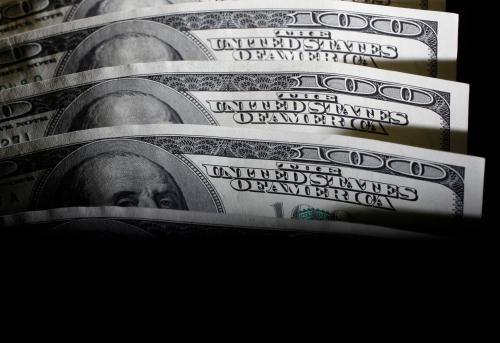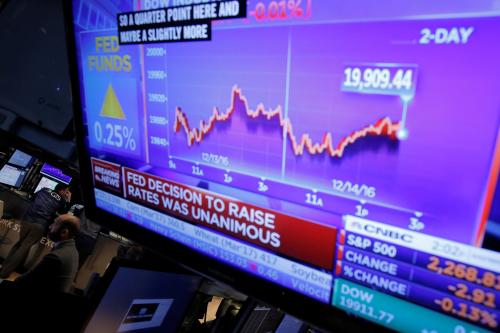This article was originally published by the Wall Street Journal on May 25, 2017.
Larry Summers is doubling down on his secular-stagnation hypothesis.
The Harvard economist and former Treasury secretary first offered the bleak diagnosis in November 2013 at an International Monetary Fund conference. The U.S. and much of the rest of the world was suffering from a chronic shortage of demand and profitable investment opportunities, he argued. There wasn’t any interest rate that would produce healthy growth (given that rates can’t go much below zero).
At a recent academic conference at the Federal Reserve Bank of San Francisco, I asked Mr. Summers how his secular stagnation hypothesis looks today, three and half years after he inserted a Depression-era phrase into today’s debate about the economic outlook. Many economists have had their doubts about his gloomy hypothesis, and not all has gone wrong with the U.S. economy. Unemployment, for example, has fallen to 4.4% from 7.2% in 2013, leading to a rise in wages.
But Mr. Summers says he has been vindicated by slow economic growth, low inflation and low interest rates, which many forecasters now expect to persist. Today, he is more convinced than ever that secular stagnation is the defining economic problem of our time—one that won’t be easily defeated as long as fiscal authorities are overly preoccupied with debt and central bankers are overly focused on keeping inflation at low levels.
Here are edited excerpts of Mr. Summers’s observations from our exchange.
With hindsight, his gloomy 2013 view looks better than the consensus 2013 view.
“When I made my comments in 2013 at the IMF they were couched with very substantial doubts. Today I would have fewer. The essence of my argument then was that because of a variety of structural factors the neutral rate of interest was much lower than it had been and, therefore, getting to an adequately low rate was going to be more difficult. And that was going to act as a constraint on aggregate demand much more of the time than people thought. Relative to the prevailing forecasts at the time that I spoke, interest rates have been very substantially lower. Growth has been very substantially lower. Inflation has been very substantially lower for the industrialized world. Fiscal policy has been more expansionary. So the broad argument that I was making at that time seems more true today.”

The decline in the U.S. unemployment rate doesn’t disprove his hypothesis.
“Nobody ever said that the economy was always going to be permanently in a state of deflation. If you go back to the Alvin Hansen [who coined the secular stagnation phrase in 1939 ], he talked about weak recovery. So here we are. We’ve managed to get to 2% growth, not much inflation pressure, 4% unemployment and in order to be there, we’ve got a fed-funds rate eight years into a recovery of 1%. I read that as, on net, something substantial has happened relative to what anybody expected rather than nothing important happened.”
Economists are no longer arguing about whether the neutral rate of interest has fallen, but instead are wondering why.
“We now have a kind of embarrassing overabundance of explanations for the decline in the neutral rate [the interest rate that will prevail when the economy is at full employment and price stability]. You got smart thoughtful people who think that demography is 75% or 80%. You’ve got smart thoughtful people who think increased risk aversion and a shortage of safe assets is 75% or 80% of it. You’ve got smart people who think widening inequality and a higher propensity to save is half of it. You’ve got smart people quantifying sludged-up financial intermediation as explaining a significant part of it. You’ve got careful thinking about declining capital-goods prices explaining a significant part of it. You’ve got people thinking about corporate savings and rising profitability as explaining a significant part of it. And nobody has come forward with strong a priori arguments for why the real rate should have increased.”
This trend has its roots in developments that preceded the Great Recession.
“One thing you should pay attention to is the yield on 10-year TIPS [Treasury Inflation-Protected Securities] because I think the interesting part is not the short-run dynamics but averaging over the cycle. If you look at the real interest rate decade by decade, it’s been going down for five decades.”
All this strengthens the case for more public investment.
“I would be trying to raise R-star [another term for the neutral rate] so I would be wanting to operate with a different fiscal-monetary mix. Even though some of the things the Trump administration is doing are giving it a bad name, the basic impulse that increased business confidence that raises the propensity to invest is a good thing. So, first, more public investment I think is a good thing.”
When pressed, Mr. Summers acknowledges a few vulnerabilities in the secular-stagnation view.
“I always try to phrase this carefully with words like ‘the foreseeable future,’ because I know that if you’d asked me in 2003 was liquidity-trap economics going to be central to understanding the American economy in the rest of my professional lifetime, I would have said overwhelmingly likely no, and I would have been wrong. So could a whole different configuration with a whole different set of issues prove to be important 10 years from now? Yeah, that could certainly happen.
One of the arguments that I’ve made is that we had the mother of all housing bubbles, we had a vast erosion of credit standards, we had really easy money, we had the Bush tax cuts plus the Iraq war, and all that got us in the precrisis period was adequate growth.
“I don’t think we’re as straight as we’d like to be on the global aspects of this. One of the arguments that I’ve made is that we had the mother of all housing bubbles, we had a vast erosion of credit standards, we had really easy money, we had the Bush tax cuts plus the Iraq war, and all that got us in the precrisis period was adequate growth. Doesn’t that show that there’s some kind of secular stagnation that you needed all that extraordinary stuff to get to adequate plus growth? That’s an argument I’ve made. It’s made a little more awkward by the very large current-account deficit we had in much of that period, which suggests that maybe there was stronger demand, and it was just falling outside the United States. I’m comfortable with my overall view, because I think this is best framed as an issue of the industrial world, but I think that this is a weakness of the line of argument that I’ve taken.
“There is some evidence related to hysteresis for what I called a Reverse Says Law—lack of demand creates its own lack of supply down the road in terms of productivity growth. But if one was attempting to synthesize everything rather than to push a very important aspect of a phenomenon that had received too little attention, I think integrating exogenous developments on the supply side would be worthwhile.”“Some people would say it’s really all the supply side, and you’re all about the demand side. We’ve had a big productivity slowdown and isn’t that the right thing for you to think about, and I think there’s obviously something to that. The point I’d make about that is that, in general, we have a way of telling the difference between supply shocks and demand shocks, which is that supply shocks raise prices and demand shocks lower prices. The general tendency to low inflation coincident with low quantity guides you a little more towards the demand-shock view therefore then the supply-shock view.






Commentary
‘Secular stagnation’ even truer today, Larry Summers says
May 30, 2017